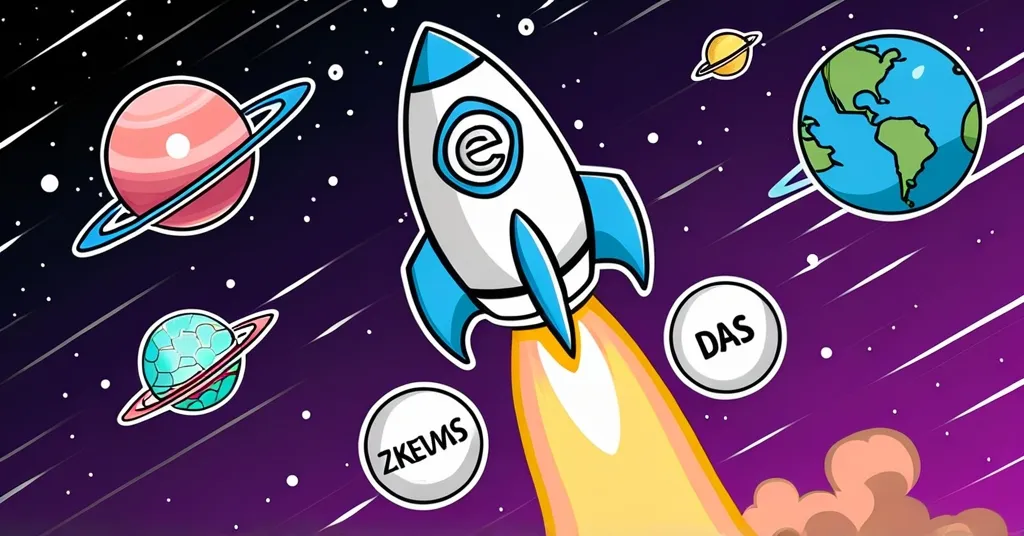Vitalik Buterin Unveils Plan to Boost Ethereum Scalability with zkEVMs and DAS

Vitalik Buterin’s Bold Plan to Boost Ethereum’s Scalability
Vitalik Buterin, Ethereum’s visionary co-founder, has a bold plan to catapult Ethereum’s scalability to new heights. His proposal aims to address the platform’s slow upgrade process and enhance its data availability (DA) bandwidth, crucial steps for Ethereum to remain competitive in the blockchain race.
- Vitalik Buterin proposes to enhance Ethereum’s data availability (DA) bandwidth.
- Current upgrade process is too slow, hindering developers.
- Scalability solutions like zkEVMs and Data Availability Sampling (DAS) proposed.
- Target: One megabyte per second DA bandwidth within a year or two.
- Goal: Support layer-2 solutions for faster and cheaper transactions.
Let’s break down Buterin’s proposal and its implications for Ethereum’s future.
The Problem: Slow Upgrades
Ethereum’s current upgrade process is slow, leaving developers in limbo and unable to plan for the future. This sluggish pace hinders the platform’s ability to scale effectively, which is essential for maintaining its position as a leader in blockchain technology. As Buterin puts it, “Ethereum’s layer-1 is thought to be incapable of scaling, and layer-2 (L2) solutions are thought to be the only viable option.” However, he challenges this notion, believing that with the right upgrades, Ethereum can indeed scale at its base layer.
The Solution: zkEVMs and DAS
Buterin’s vision involves turbocharging Ethereum’s layer-1 with technologies like zkEVMs (Zero-Knowledge Ethereum Virtual Machines) and Data Availability Sampling (DAS). zkEVMs enable transactions to be processed more privately and efficiently by using zero-knowledge proofs to validate transactions without revealing the underlying data. Meanwhile, DAS aims to streamline how data is handled on the network, making transactions faster and more efficient. Buterin’s ambitious goal is to boost Ethereum’s data availability bandwidth to one megabyte per second within the next year or two, a significant leap from the current capabilities.
These technologies aren’t just buzzwords; they’re critical pieces of the puzzle to scale Ethereum’s base layer significantly. Buterin’s not just tweaking the Ethereum codebase; he’s trying to give it a turbo boost while it’s still flying. But can these upgrades be implemented smoothly and securely? That’s the million-dollar question.
The Stakes: Ethereum’s Future
The stakes are high for Ethereum. “Buterin warns that Ethereum needs to grow rapidly in order to remain relevant.” If Ethereum doesn’t scale quickly enough, it risks being outpaced by newer, more agile blockchain projects. To counter this, Buterin suggests incorporating Data Availability Provider nodes with stricter specifications, a move he believes can increase scalability without compromising security.
Ethereum’s ability to support layer-2 solutions like rollups, which promise faster and cheaper transactions, hinges on these upgrades. Rollups are like mini-blockchains that process transactions off the main Ethereum network, then submit the results back to Ethereum for security. If Ethereum can scale its layer-1, it could provide a more robust foundation for these layer-2 solutions, enhancing the entire ecosystem.
Counterpoints and Challenges
While Buterin’s vision is compelling, skeptics argue that achieving such rapid scalability could introduce new security risks. Scaling a blockchain is like trying to upgrade a plane’s engine mid-flight—challenging and fraught with potential pitfalls. Some experts worry that rushing these upgrades could lead to vulnerabilities that malicious actors might exploit.
Moreover, the Ethereum community must reach a consensus on these changes, which can be a slow and contentious process. As a champion of decentralization, we can’t help but root for Buterin’s vision, even as we question its feasibility. The path to scalability is fraught with technical and social challenges, but the rewards could be transformative.
Real-World Implications
If Ethereum’s scalability improves, it could lead to more widespread adoption in areas like decentralized finance (DeFi) and non-fungible tokens (NFTs). DeFi, often compared to a decentralized version of Wall Street, relies on Ethereum’s ability to handle a high volume of transactions efficiently. NFTs, which are unique digital assets, also benefit from faster and cheaper transactions. Improved scalability could unlock new possibilities in these and other areas, potentially overshadowing other blockchains like Bitcoin in certain niches.
However, it’s important to remember that Ethereum isn’t the only player in the blockchain game. Other platforms are also working on scalability solutions, and the competition is fierce. Ethereum’s success in scaling could have ripple effects across the entire blockchain ecosystem, pushing other projects to innovate or fall behind.
Key Takeaways and Questions
- What is the main issue Vitalik Buterin is addressing with his new proposal for Ethereum?
The main issue is the slow upgrade process of Ethereum, which hinders developers’ ability to plan long-term and affects the platform’s scalability. - How does Buterin propose to improve Ethereum’s scalability?
Buterin proposes using technologies like zkEVMs and Data Availability Sampling (DAS) to significantly scale Ethereum’s layer-1, aiming for a 100-1,000 times growth in a few years. - What is the target for data availability bandwidth improvement?
The target is to increase the data availability bandwidth to one megabyte per second within a year or two. - Why is it important for Ethereum to enhance its data availability?
Enhancing data availability is crucial to support layer-2 solutions like rollups, which can provide faster and cheaper services, thereby strengthening Ethereum’s ecosystem and maintaining its relevance. - What risks does Ethereum face if it does not scale quickly?
Ethereum risks losing its position as a leading blockchain platform if it does not scale quickly enough, as developers may turn to alternative solutions.
Stay tuned to “Let’s Talk, Bitcoin” for ongoing coverage of Ethereum’s scalability journey and its impact on the future of decentralized technology.



